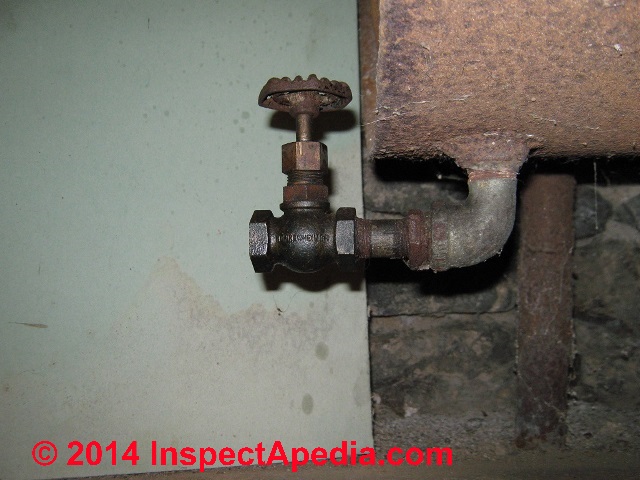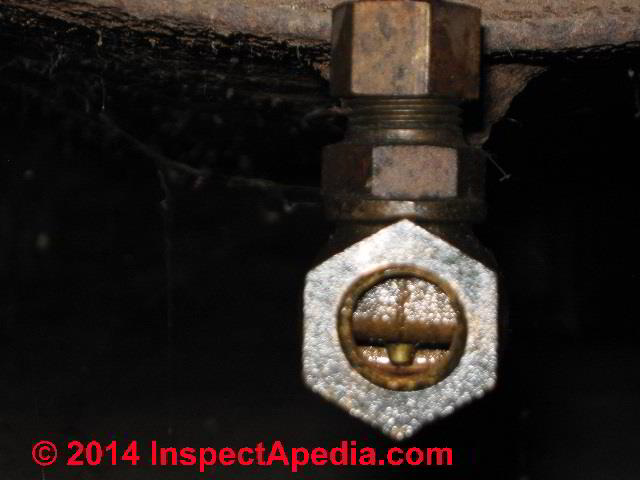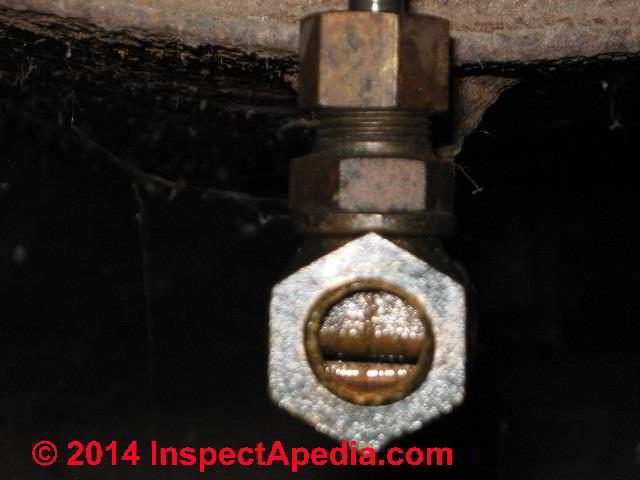 Heating Oil Tank & Piping Sludge FAQs
Heating Oil Tank & Piping Sludge FAQs
Q&A about lost heat due to oil tank sludge
- POST a QUESTION or COMMENT about heating oil tank sludge, clogs, and relating heating equipment malfunctions
Q&A about sludge & crud or contaminants in heating oil storage tanks.
This article series explains the causes and cures for heating system problems due to sludge in home heating oil tanks, including problems of clogged oil piping, clogged oil filters, oil burner malfunctions, and loss of heat due to sludge in the oil tank.
InspectAPedia tolerates no conflicts of interest. We have no relationship with advertisers, products, or services discussed at this website.
- Daniel Friedman, Publisher/Editor/Author - See WHO ARE WE?
Heating Oil Tank Sludge FAQs
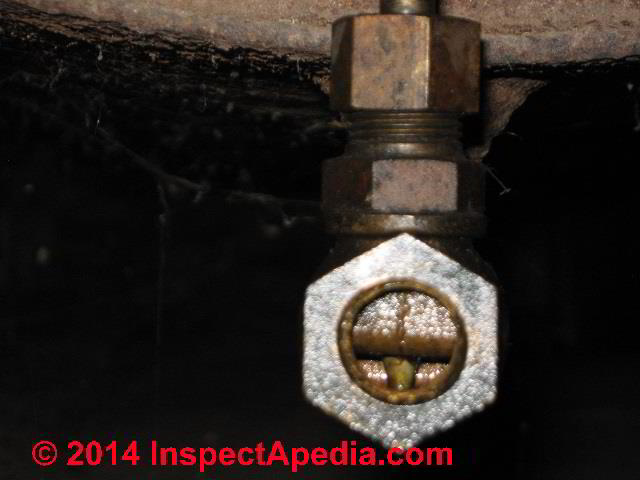 These questions and answers about sludge in oil tanks and the resulting problems of clogged heating oil lines, filters nozzles, or dirty / debris-loaded heating oil tanks were posted originally
These questions and answers about sludge in oil tanks and the resulting problems of clogged heating oil lines, filters nozzles, or dirty / debris-loaded heating oil tanks were posted originally
at OIL TANK SLUDGE - please be sure to review that article series.
Question: would a blocked oil line or sludge problem cause oil smells in my house?
Is this why i smell a oil smell when coming into the house. ? how do i know what caused this? - Anon 5/10/11
Reply:
Sludge in the oil tank would not itself be the first cause of an oil smell in the home. More likely that odor would be from an oil leak in the piping system or an oil spill during fill-up.
Also see HEATING SYSTEM ODORS at page top or left
Question: should we switch from oil to natural gas?
A more reliable and much less costly solution is to switch to natural gas. Imagine how much time and effort, not to mention anxiety late at night on cold nights when the heat stops, would be saved by eliminating the messy, apparently insoluble problem in the first place. - John Coburn 5/16/11
Reply: one size does not fit all
Both oil and natural gas as heating fuels have their own individual advantages and disadvantages.
But the switch to natural gas is simply not an option in areas where no natural gas service is available. In those locations the switch would have to be from oil to LP gas, requiring the installation of a sufficiently large LP gas tank and appropriate piping, as well as of course complete replacement of the heating equipment.
Question: how do I extend the fuel line up from the bottom of the oil tank to get above the sludge? How can I install an extension without creating an oil spill in the process?
 Are there any standard extensions available to extend the furnace fuel line up into the oil tank?
Are there any standard extensions available to extend the furnace fuel line up into the oil tank?
For a DIY, a 1/2" copper pipe fits snugly inside a 1/2" iron pipe nipple and the assembly screwed into the tank outlet. Is a 2" extension about right. Unless the tank is empty or nearly so this can be a little messy. - Gil 8/20/11
Reply:
Interesting idea, Gil, but not a part I've come across.
In cases I have dealt with in which there was sludge in the oil tank bottom (or water) we
- asked the oil company to pump out and remove as much as they could
- ran the oil piping out of the top of the tank (as in our photo), and made sure the tubing stopped several inches from tank bottom
- installed larger capacity or even dual in parallel oil filters to protect the oil burner and keep the system running.
Those are steps you can take that avoid having to drain the tank and having to make a leaky oil mess on the floor trying to retrofit a solution from the bottom of the oil storage tank.Of course if you are using a one-line oil system and relying on gravity, depending on where tank and oil burner are located, going to a two-pipe system could require more changes at the fuel unit, and more cost;
It is probably possible to pump out the oil tank or use up most of its oil, try blocking the drain at tank bottom from inside temporarily, or just work quickly over a pan large enough to catch the brief oil spill as you remove the old fittings and install the new ones (having them ready and prepped at-hand).
Reader follow-up:
Thanks for your comments. I did ask my oil company if they could pump out the sludge and they said no.
I have had this company for a long time and they treat me well so I hesitate to go elsewhere. I used a 3 GPM oil pump to vacuum most of the sludge along the bottom of the tank but did not try to clean very far up the sides. I also pumped out the line to the furnace.
My furnace man did not recommend a line from the top unless we went to a two line system.
That got a little pricey for a problem that seemed solvable another way. I did search suppliers of new tanks to see if they offered an extension piece with new installations but did not find any. I'll look further.
At this point there is about 8" of oil in the tank and I can lower a weighted plastic bag over the outlet to help minimize spillage when removing the outlet line. I have a temporary plug ready and then plan to replace the nipple in the outlet plumbing with my made up extension piece.
The outlet plumbing includes a shut off valve which also helps minimize spillage. - Gil 8/12/11
Reply:
Good project Gil. Send us some photos of your procedure and parts solution - it may help other readers. Use the CONTACT link at top, side, or bottom of any page
Reader follow-up:
Mission is accomplished! The extension of the fuel line is in place in the oil tank and all is reassembled.
The spillage was minimal, most was caught in a motor oil pan and plenty of newspaper for the splash. I did photograph the extension piece but it is simply a piece of 1/2" copper pipe inside a 1/2" iron pipe nipple.
I did secure the copper piece with solder. I can e-mail more details if it would be useful but it may be a week or so. 8/13/2011
Question: two line continuous flow oil piping - do we need an oil filter on the line?
Our oil tank was installed ~ 15 years ago. It has a 2 pipe from the top system to deliver oil to the burner.
The Company called it a continuous flow system. Yesterday a new tech came out to service the furnace and said we needed a filter on the line. Is this necessary for a 2 line top system? We lean to the if it isn't broke don't fix it school. - Kathleen 10/25/2012
Reply:
Kathleen, no modern oil fired heating system should be run without a filter on the supply line ahead of the oil burner itself - doing so is asking for higher service costs and loss of heat as crud in the oil clogs the oil burner.
It's already "broke" and asking for trouble.
Question: flame goes out or changes color on my AGA/Kerosene Cooker
The blue flame of my aga/kerosene cooker disappeared and heat was reduced when I left the door that houses the burner open flame returned and heat please explain - Carol 11/20/12
Folks who shout in all caps get tiny font.
Reply:
Carol:
Watch out: your heating appliance may be unsafe - and may be lacking adequate combustion air; You need help from a qualified installer/repairman to be sure that your system has proper combustion air supply and that the air intake to the appliance itself has not become blocked.I suggest having it examined by an expert. I suggest contacting AGA directly for help and to obtain a technical guide for your heater.
The size of combustion air inlet opening required for your AGA kerosene heater/cooker depends on the model and will be specified in its installation instructions; For example, the similar Rayburn 600K requires 61 cm2 of unobstructed air intake area. The company points out that for this model, an oil fired unit,
The air controls of the burner are factory pre-set, however small adjustments may be necessary to suit the site conditions. [15]
You will want to review the installation and operation manual for your AGA heater - easily downloaded from the company's website.
AGA, Station Road, Ketley, Telford, Shropshire, TF1 5AQ, UK, rayburn-web.co.uk
Question: Rayburn Cooker / Heater won't work, is the oil line still clogged?
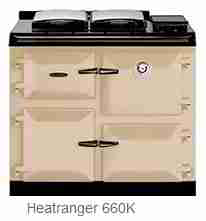 My Rayburn isn't working. It will start up and then promptly shut down. Can the oil line still be clogged if I bled the line and the kerosene ran clear and without disruption? - D.Witmer 1/3/12
My Rayburn isn't working. It will start up and then promptly shut down. Can the oil line still be clogged if I bled the line and the kerosene ran clear and without disruption? - D.Witmer 1/3/12
Reply:
D Witmer:
We're guessing that your Rayburn Heater is a UK device similar to the AGA heater. Rayburn makes cooking appliances, solid fuel, wood, oil, gas and electric heating appliances. Model specifications also vary between in-UK and export equipment.
For example the Rayburn Heatranger includes a cook stove, and it also provides hot water and/or central heating, thermostatically controlled to automatically maintain a constant temperature.
You can contact AGA, Redfyre, or Rayburn directly at AGA, Tel: 08457 626 147, or 08458 152 020, Website: rayburn-web.co.uk. In our references we include more contact information for AGA or Rayburn. [15]
The company's website provides links to both current and obsolete products' installation manuals and parts lists.
If you have not already done so, I would start by checking or replacing the oil filter that was supplied with your Rayburn heater. Usually the oil filter is located close to the wall where the oil line enters the building, or inside close to the heater itself.
Rayburn also requires a fire-safety heck valve in the oil line; check that your valve is not closed or jammed.
There are other things to check such as for an air leak or failure to purge air from the line after a de-clogging operation; I expect your service tech would also perform a vacuum test on the oil piping system.
Question: how to drain sludge out of an old oil tank - close inspection finds oil tank bottom shutoff valve not operating properly
My oil(#2) tank has the two line top feed. Trying to drain sludge and or water from the tank I opened the valve at the bottom of the tank and nothing flows out.
There is a little oil/water (I'm guessing) in the outlet. I tried poking the plastic sleeve of a 12ga. wire through in case the valve is clogged with sludge.
[Click to enlarge any image]
When I open and close the valve all I see is a small pin of brass(?) going up and down in a much larger area.
I do not see a gate moving in the valve. I haven't been able to find helpful information about the valve(body reads Lunkenheimer) on the internet.
What if anything can you tell me about this valve or why it doesn't seem to be doing anything. Thank you. 2/8/2014 Tracy
Reply: Lunkenheimer oil valve stops working
Tracy,
It sounds as if the tank bottom drain is plugged with sludge - if in fact it's a valve. A small brass pin ? Sounds like an air valve (looks like a tire valve) that would have no business being installed on an oil tank. More likely I just didn't understand your question.[Photos above & below illustrate this oil tank valve made by Lunkenheimer]
Above we see the Lunkenheimer oil tank valve in the "closed" position. Below the reader's photo shows this valve when the valve handle & stem are in the "partly open position" - you can see virtually no change in the actual valve opening.
Watch out: I would not mess with a tank bottom valve at all in this situation; if you start disassembling or unscrewing and your oil tank suddenly spits out its sludge plug, you could have a flood of heating oil on the floor, creating a costly catastrophe.
That's perhaps why oil companies prefer to try pumping sludge and water out of the tank from the tank top, along with adding an oil tank additive that is intended to break up sludge (and can quickly clog the heating oil burner or its filter).
Indeed Lunkenheimer is a producer of a range of control valves used on heating equipment.
You can perhaps identify and then read about your particular valve in the Lunkenheimer product catalog available at the company's website. lunkenheimercvc dot com [no links are included in comments for security reasons] or you can contact the company'sU.S. outlet at Cincinnati Valve Company
sales AT lunkenheimercvc [dot] com
P: 513.471.8258 | F: 513.471.8327
P. O. Box 141451, Cincinnati, OH 45250-1451, U.S.A.Reader follow-up: photos of old Lunkenheimer oil tank valve
Before I contacted you I did go to Lunkenheimer's site. Not being a mechanic or engineer I did not see anything there that helped me.
Yes, without pictures or a better description it would sound like an air valve and for all I know and what I know about the previous owner of this house it could be. Here are the pictures.
Reply: warnings about messing with the valve at the bottom of an oil tank: oil leak risk
Great photos. Bad news. It looks as if the gate valve is not opening; We could be looking at a backflow preventer mechanism, but I suspect that instead, on this valve the gate stem is broken inside the valve - so it doesn't lift the gate.
If the valve seems to turn a bit easily and in particular if in turning the handle the handle stem doesn't move up or down it's probably not moving the actual gate in the valve.
On some gate valves the stem will actually turn and even rise up or move down in the valve body, but as the stem end has broken away from the valve gate, the valve never actually opens or closes. This is what I think is happening with your valve.
The oil tank valve photograph below shows this same Lunkenheimer valve in the fully "open" position - actually it's not open.
Advice against trying to replace this bottom-mounted oil tank control valve
Instead of trying to replace this valve, I'd prefer to see the valve opening capped so that it cannot leak at all. Then address the oil tank sludge in the other ways we've discussed.
A plumber, putting down a big pan to catch spilling goop, and who was very nervy and very confident might be willing to try to replace the valve but considering the costs of trying to clean up a big oil spill I figure most will not be willing to touch it.
Or an plumber experienced with changing out valves on live water lines might try freezing the short pipe nipple connecting the valve to the tank, then swapping out the valve.
But again, it's a risky proposition that, considering how sludge clogs stuff up, probably is not the best approach anyway.
I speculate that even if you opened the valve the sludge would clog that opening before accomplishing any useful sludge removal.
BE CAREFUL as I warned before, I'm worried that you'll open the valve and not be able to shut it - flooding the place with oil.
Usually the oil co will pump out as much sludge and water as they can - from a fitting at the tank TOP, then use the additives I cited - like 4 in 1 HOT pour point depressant that also includes a sludge dissolver.
I speculate that the sludge is so goopy that it's not going to flow out of the valve even if you could open it (water would).
If we're working on this because your tank is picking up sludge through the tank top fitted oil line(s) the fix is more often to raise up the lowest end of the tank oil pickup line that inserts into the tank from the top - get it above the sludge level.
That may mean you will draw a bit less oil out of the tank before needing a new delivery, but usually that will get you by until you're ready to replace the tank (or if it's tested and found sound you could have the tank professionally cleaned - but we don't ususally find that cost justified for residential oil tanks);
In addition to drawing up the lower end of the oil pickup line from the tank top, on a similar problem system we installed double oil filters, side by side, in parallel, so that we could filter out the stirred-up sludge (from oil deliveries) without having the oil filters clog early. (Oil filters get replaced at annual service).
I speculate that valve stopped working a long time ago, after having served for years as a connector to a bottom-connected oil line. The then owners or their service tech realized the danger of trying to change it and instead left it in place, closed, opting to change over to taking oil from the top of the oil tank.
Question: advice for using oil tank sludge & water removing treatment chemicals
(July 31, 2014) Linda said:
OK. I have an original?(1940) above ground 275 fuel oil tank that presently is @ 1/4 full.
I want to add Hercules Fuel Oil sludge treatment to it & wonder the following:
if 1 pint is recommended dosage for this size tank, and I only want to order 100 gals of oil (as we may change systems before winter) how much should I pour in before the delivery & how soon after pouring should delivery be done?
I asked my fuel oil supplier and he said he didn't know. I called Hercules, who sold to Ody? and a diagnostic expert said it's best to add it in when tank is empty--as the container treatment also states "as low as oil level as practical".
Since the chemistry that needs to take place is emulsification, can I get away with just ordering 100 gals and using half a pint? Or is there some other methodology? Thank you very much.
Reply:
Linda,
Take a look at the treatment advice on the product label. Typically the dose is a bottle for 250g of heating oil. I can't imagine any benefit to adding the treatment with the tank nearly empty though I can imagine what your diagnostic expert may have himself or herself imagined even if it's not the manufacturer's recommendations. We'll skip that.
Yes of course you could adjust the dose to match the delivery quantity of oil or tank quantity of oil.
The product both breaks up sludge and helps remove oil, in theory transporting them through the piping and burner to be consumed.
The best time to add a treatment is immediately before an oil delivery - as then the delivery mixes the treatment with the new oil and also (usually) stirs up sludge and water in the tank.
WATCH OUT: you may find you need to change the oil filter at each oil burner frequently (or install higher capacity filters) lest the filter clog with the sludge that's now moving through the system. You'll read in the article above that we had to do that to keep the oil burner running between annual cleanout service times.
I add that if there is a lot of water in the tank it should be pumped out.
Followup: Linda said:
Thank you; you've helped. Instead of changing the filter, we cleaned (washed) it & it came out
as new; but I will be on lookout for any slowdown coming aaro the emulsified sludge now coming thru the system.Nice to put knowledge to work!
Reply:
Good for you. Oil filter cartridges are really cheap - I suggest buying a half dozen and putting them to work.
Question: can high water pressure cause trouble with my heating pipes?
20 January 2015 Ameenah said:
I was wondering if high pressure could cause problems with my oil heater ?
My neighbor got a new water pipe run underground, that was Friday, after it was done, I noticed my pipes started clanking and the water in my kitchen would come on very and it had force behind it, when I first tuned it on in the morning. Tuesday, my heater shut off, it is a connection to the plumbers being underground or it is a coincidence, the clanking and the water pressure in the kitchen did not take place until after the plumbers went underground.
Could there be a connection to the heater and the water pressure ?
Reply:
Ammenmah
I'm unclear why your neighbor's piumbing work changed your building water pressure.
But yes an increase in building water pressure can cause water hammer problems as valves at sinks or even heating zones turn off.
See
inspectapedia.com/plumbing/Water_Hammer_Noise.php
for details on diagnosing and fixing these noises.
...
Continue reading at OIL TANK SLUDGE or select a topic from the closely-related articles below, or see the complete ARTICLE INDEX.
Or see OIL TANK SLUDGE FAQs-2 - more-recent questions & answers about dealing with sludge, water and other crud in heating oil storage tanks.
Or see these
Recommended Articles
- HEATING OIL CLOUD WAX GEL POINT
- OIL TANK SLUDGE
- OIL TANK REPLACE due to SLUDGE?
- OIL TANK TREATMENTS, ADDITIVES
Suggested citation for this web page
OIL TANK SLUDGE FAQs at InspectApedia.com - online encyclopedia of building & environmental inspection, testing, diagnosis, repair, & problem prevention advice.
Or see this
INDEX to RELATED ARTICLES: ARTICLE INDEX to HEATING OIL, OIL BURNERS, OIL FIRED HEATERS, OIL TANKS
Or use the SEARCH BOX found below to Ask a Question or Search InspectApedia
Ask a Question or Search InspectApedia
Try the search box just below, or if you prefer, post a question or comment in the Comments box below and we will respond promptly.
Search the InspectApedia website
Note: appearance of your Comment below may be delayed: if your comment contains an image, photograph, web link, or text that looks to the software as if it might be a web link, your posting will appear after it has been approved by a moderator. Apologies for the delay.
Only one image can be added per comment but you can post as many comments, and therefore images, as you like.
You will not receive a notification when a response to your question has been posted.
Please bookmark this page to make it easy for you to check back for our response.
IF above you see "Comment Form is loading comments..." then COMMENT BOX - countable.ca / bawkbox.com IS NOT WORKING.
In any case you are welcome to send an email directly to us at InspectApedia.com at editor@inspectApedia.com
We'll reply to you directly. Please help us help you by noting, in your email, the URL of the InspectApedia page where you wanted to comment.
Citations & References
In addition to any citations in the article above, a full list is available on request.
- In addition to citations & references found in this article, see the research citations given at the end of the related articles found at our suggested
CONTINUE READING or RECOMMENDED ARTICLES.
- Carson, Dunlop & Associates Ltd., 120 Carlton Street Suite 407, Toronto ON M5A 4K2. Tel: (416) 964-9415 1-800-268-7070 Email: info@carsondunlop.com. Alan Carson is a past president of ASHI, the American Society of Home Inspectors.
Thanks to Alan Carson and Bob Dunlop, for permission for InspectAPedia to use text excerpts from The HOME REFERENCE BOOK - the Encyclopedia of Homes and to use illustrations from The ILLUSTRATED HOME .
Carson Dunlop Associates provides extensive home inspection education and report writing material. In gratitude we provide links to tsome Carson Dunlop Associates products and services.


